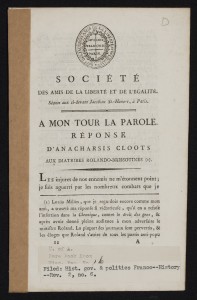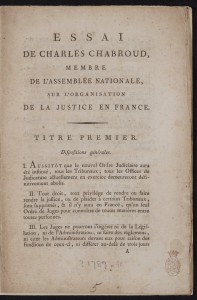By: Amy Chen, CLIR Postdoctoral Fellow
In honor of Bastille Day, this week Cool@Hoole will provide readers with a three-part overview of the Division of Special Collection’s French holdings. On Monday, early modern books were covered and on Wednesday, the French Enlightenment was explored. Today, on the last day of our series, we will conclude with a discussion of French Revolutionary pamphlets.
To provide a brief history, the French Revolution began in 1789 when the French proletariat stormed the Bastille on July 14. In August, the National Assembly abolished feudalism and released the Déclaration des droits de l’homme et du citoyen (Declaration of the Rights of Man and the Citizen). June 1790 brought the abolition of the nobility and, in May 1791, the Assembly determined that all citizens are equal, regardless of their skin color. King Louis XVI accepted the Constitution on September 1791, but he was tried for high treason in December 1792 and executed in January 1793. By October 14, 1793, his Queen, Marie Antoinette, also was executed. Further executions would follow during the Reign of Terror, which lasted from roughly September 1793 through July 1794. In 1797, Napoleon Bonaparte began his ascent to power; in 1799, he staged a coup that consolidated his rule as first consul. In 1804, he became Emperor, a title he would hold until 1815, with the exception of a period between 1814 and 1815, when he was placed in exile on the island of Elba.
During this time, pamphlets were used to discuss human rights, the roles of citizenship, and class identity. Alabama holds 319 French Revolution pamphlets, which have been digitized and are available on Acumen. Take a moment to explore these pamphlets, which have had their interior pages as well as their covers digitized. Privately printed and meant to be ephemeral, these pamphlets served as an important medium to keep everyday citizens abreast of political and intellectual events during this significant era of French history. Their preservation allows us to read the words that shaped the discourse of the Revolution, which changed the history of France and, eventually, influenced global society to begin to consider the rights of citizens.
The pamphlets pictured here are A mon tour la parole: réponse d’Anacharsis Cloots aux diatribes Rolando-Brissotines (1792) and Essai de Charles Chabroud, membre de l’Assemblée nationale sur l’organisation de la justice en France (1790).
If you are interested in seeing pamphlets held at other universities, check out those from Ball State, Emory, and Brandeis. The Newberry Library and the National Library of Australia also have substantial holdings in this area.


